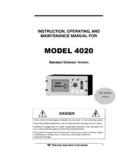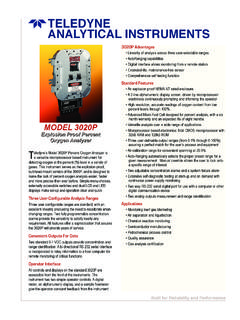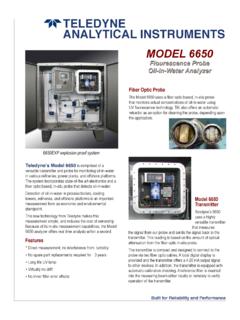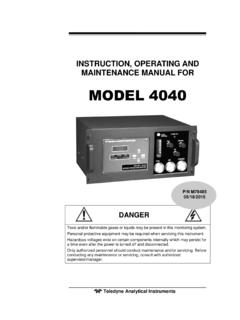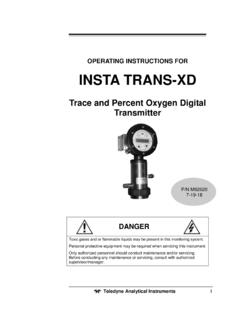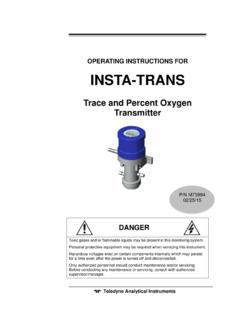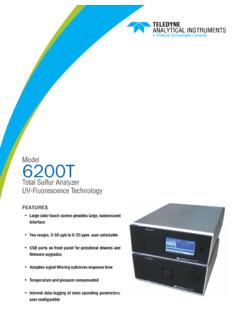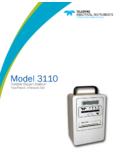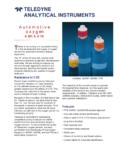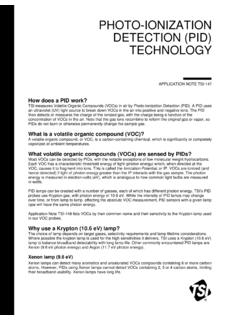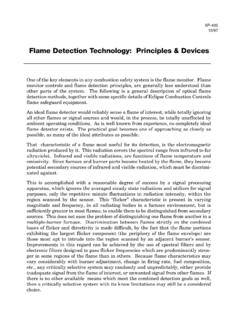Transcription of Gas Chromatographs - Teledyne Analytical Instruments
1 4060 Gas ChromatographsSeries4060 SERIES - GAS CHROMATOGRAPHS2 Series 4060 Overview The Teledyne Analytical Instruments (TAI) Series 4060 speciates gases of interest by combining well-accepted gas chromatography techniques with TAI s field-proven detector technologies. This combination, along with effective electrometer-based signal amplification and temperature control, enables the Series 4060 to detect either single or multiple compounds in a background gas possessing potentially interfering ChromatographyComponent separation is achieved using an appropriate packed column.
2 The column consists of a suitable length of inert stainless steel tubing packed with particles of porous polymer or bonded phase materials of varying length and diameter (per application). The coating interacts less with smaller and more volatile compounds, causing them to pass more quickly through the column than larger and less volatile compounds. In some cases, multiple columns may be employed to achieve a quick and thorough speciation of the parameters of inert carrier gas is used to push the sample through the column at a constant flow rate.
3 With proper temperature and pressure control, the time it takes each gas to exit the column is sample exiting from the column then passes through the detector. The sensor response during the time a gas of interest is detected is integrated into a volumetric Chromatography ColumnChromatogramRetention TimeACABNZTOLETBXYLFW26788 BWColumn SeparationBSlow ElutionAFast ElutionCompoundMixtureA+BCross-Section of a ColumnOptimal control of temperature and flow rates for the column, detector and sample handling components is critical for stable, repeatable readings.
4 The Model 4060 sample system is sealed and insulated, utilizing PID controllers to ensure the ultimate temperature stability of the switching valve and column/detector compartment. Tubing, fittings and components within the sample system are 300-series stainless steel and carrier gas and other applicable utility gases are regulated using miniature stainless steel regulators with gauges for precise pressure control. Proper flow rates to the detector are ensured with fixed orifices. All adjustable pressure and flow devices are easily accessible from the front panel.
5 Both rack-mount and wall-mount configurations provide easy access to sample system components for 4060 utilizes a switching valve with two states. The first is a sampling state, which collects a precise volume of the sample while bypassing the carrier gas to the vent. The valve is then actuated to an analysis state where the speciated gas of interest is then pushed through the sample loop by the carrier gas and on to the detector for analysis. The signal peaks are then collected and the gas concentration(s) measured and displayed.
6 4060 SERIES - GAS CHROMATOGRAPHS3 Sample Handling System4060A TCD Rack-Mount Analysis CompartmentPID Controllers4060B FID Wall-Mount Analysis CompartmentBecause of its high sensitivity to most organic compounds, the flame ionization detector is a powerful tool for measuring hydrocarbon impurities in gases. It also provides a linear response over a wide range of analysis. Figure A shows the general construction of an FID. Organic compounds from the sample stream or separation column are injected into the detector housing where they are mixed with Hydrogen and air before entering the detector jet where the mixture is burned.
7 During this process, organic compounds are broken down into carbon fragments and acquire a positive charge ( , become ionized) at the surface of the anode. Carbon fragments are detected by the collector. The signal is then amplified and sent to the data processing systemDetector TechnologiesA thermal conductivity detector measures levels of a gas by its ability to conduct heat. The cell block is heated to a fixed temperature; it consists of four filaments arranged in a Wheatstone bridge configuration.
8 Two filaments are exposed to a reference gas (sealed or flowing) of a known thermal conductivity, while the other two see the sample gas being measured. A reference voltage is applied across the the measuring filaments are exposed to a gas of the same thermal conductivity as the reference filaments, the bridge will be balanced (the differential voltage will be zero). However, if the thermal conductivity of the measuring gas changes, the filaments temperature will increase or decrease respectively.
9 This change will affect the electrical resistance across the filaments, which creates a measurable voltage differential proportional to the volumetric concentration of the gas of Conductivity Detector (TCD) flame - ionization Detector (FID)4060 SERIES - GAS CHROMATOGRAPHS4 flame ionization Detector (FID)Figure AThermal Conductivity Detector (TCD)Figure BRegulated Power SupplyMeasuringSignalReference SignalReferenceGas FlowSampleGas Flow4060 SERIES - GAS CHROMATOGRAPHS5 Electronic InterfaceCommon Detectable Gases (Contact TAI for feasibility on other applications)
10 * Measurement achieved with methanizerFeatures Field-proven microprocessor-based electronics provide menu-driven functionality Easy-to-view 5-digit LED display for readings 2x20 vacuum fluorescent display for menu options, settings, and status Built-in diagnostic capability EEPROM to store factory defaults in the event of loss of power Ready for auto-calibration and remote-calibration with external solenoid valves (integral cal valves available as option) Automatic flame ignition / re-ignition and flame -out guard circuitry (for FID detector) Methanizer available with FID version for detection of carbon monoxide and carbon dioxideI/O 0-1 VDC and 4-20 mADC (isolated) analog outputs 0-1 VDC and 4-20 mADC gas identification outputs RS-232 duplex digital output Two (2) fully-configurable concentration outputs with Form-C relay contacts System alarm with Form-C relay contact Next Generations will have up to four (8)
